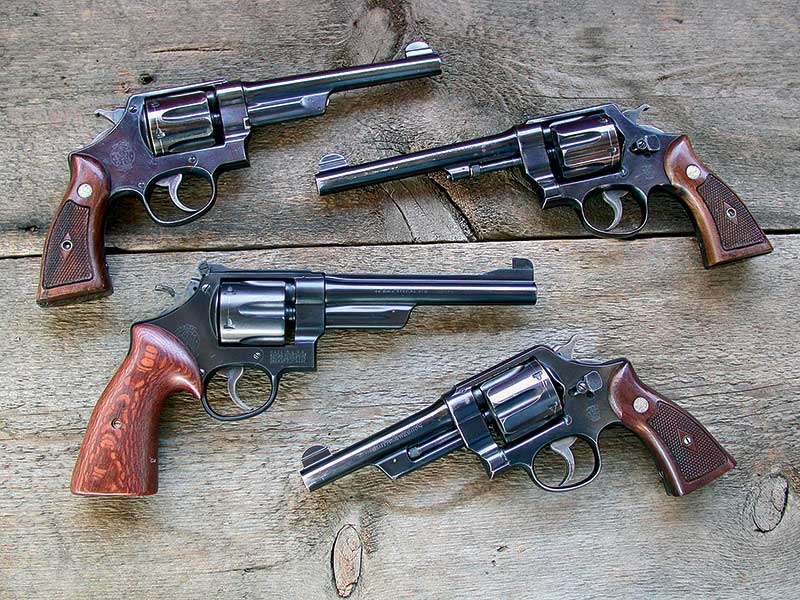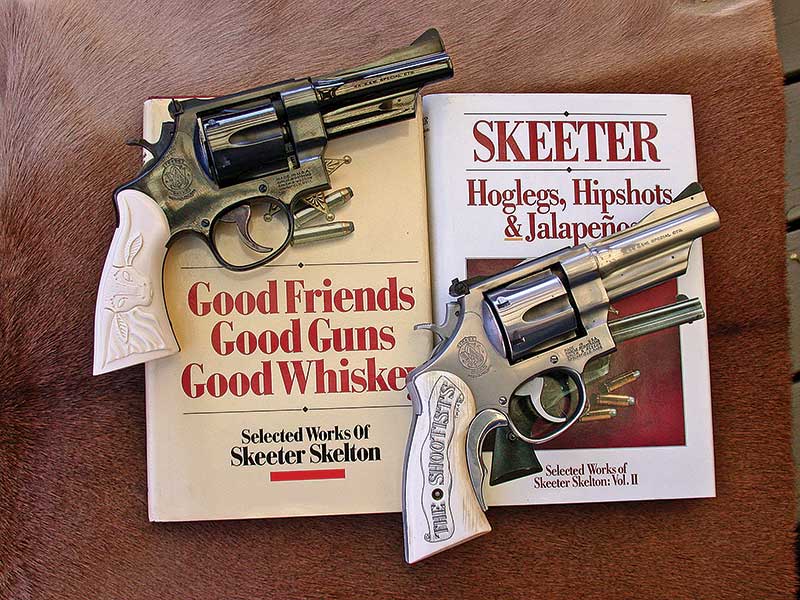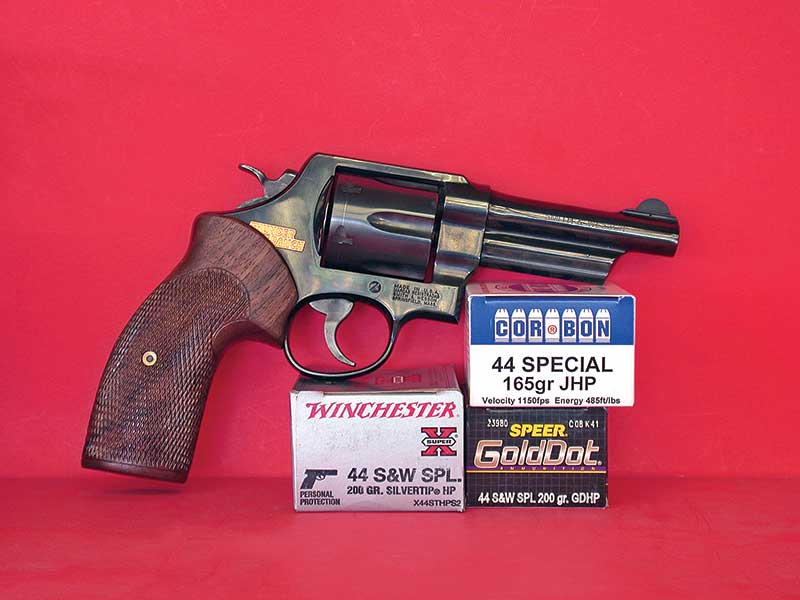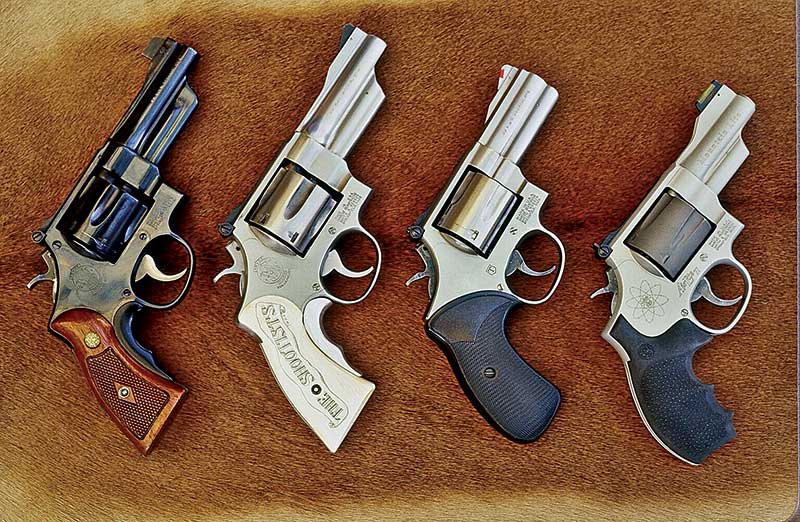.44 Special DA Sixguns
The Do-Everything Revolver
In the closing days of 1908 Smith & Wesson brought forth a new sixgun which was destined to have great impact for most of the 20th century. The same basic sixgun platform would go on to be chambered in .45 ACP, .38/44 Heavy Duty, .357 Magnum, .44 Magnum, .41 Magnum, and rarely .45 Colt. That revolver was the New Century, or First Model Hand Ejector, or as it’s most commonly known, the Triple-Lock.
The first chambering was none of the above classic cartridges, but rather the Triple-Lock introduced the .44 Special, and the revolver itself was the first N-frame Smith & Wesson. As might be expected it was beautifully crafted, gaining its name from the fact the cylinder locked in three places, at the front of the ejector rod and at the rear of the cylinder, while a third lock was a magnificently machined between the back of the ejector rod housing and the yoke. Subsequently, historians have said the third lock was not necessary, but instead highlighted the extreme talents of Smith & Wesson craftsmen prior to WWI. The Triple-Lock was also the first Smith & Wesson double action sixgun with an enclosed ejector rod housing.
As beautiful machined as the Triple-Lock was it was to be short lived. In 1915, to save manufacturing costs, the enclosed ejector rod and the third locking feature were dropped as the Second Model Hand Ejector arrived with a retail price of $2 less than the Triple-Lock. A measly 2 bucks! The Second Model was still chambered in .44 Special, however the vast majority were made for the military use in WWI.
For the American Expeditionary Force the chambering was .45 ACP, while revolvers for the British chambered the .455. After the war, dedicated sixgunners began to petition Smith & Wesson to bring back the Triple-Lock but it never happened. However, thanks to Texas distributor Wolff & Klar the Third Model, or 1926 Model, returned the enclosed ejector rod housing. This model was produced side-by-side with the Second Model until the eve of WWII and even for a few years after that, when the final Hand Ejector, the Model of 1950, replaced it.
Still Strong
My first ever Smith & Wesson .44 Special was a 61/2″ 1950 Target. In the early 1960s that original .44 Special had to be sacrificed to buy groceries for my three young kids who insisted upon eating regularly. As usually happens, time healed the hurt and the 1950 Target, which was lost has been replaced several times over, with different models. These are simply some of the finest double-action .44 Specials ever produced.
Smith & Wesson dropped the .44 Special in the 1960s, however it was resurrected for a couple years in the 1980s as the blued Model 24-3 and stainless steel Model 624 with both offered in 4″ and 61/2″ versions. Just recently Smith also brought back the basic Model 24 in the Classic series. These are all excellent sixguns.
Thanks mainly to Clint Smith, Mike Venturino and American Handgunner, the 4″ Military .44 Special was reborn as the Thunder Ranch Special. Smith & Wesson also offered the .44 Special in a 5-shot Model 696 L-frame along with a Model 296 lightweight five-shooter. Both demand high dollar prices today.
A Taurus Model 681 5-shot .44 Special I have is prized as it has been worked over by Bill Oglesby. He added high visibility sights, smoothed out the action, de-horned the hammer, all of which turned it into a first-class defensive double-action sixgun. I also have had Charter Arms Bulldog .44 Specials through the years, and still rely on the model today.
Working Loads
My every day working load with the Models of 1950 and 1926 is what most sixgunners know as the Skeeter Skelton Load, namely a 250-260 Keith bullet over 7.5 grs. of Unique, for 950 to 1,000 fps. The same results can be had with the same amount of Universal or 8.0 grains of Power Pistol. For the past half-century plus I have virtually fired every revolver manufactured and chambered in everything from the .22 Long Rifle up through the biggest of the big bores. I have said more than once I could quite easily fill out my remaining years with a good quality .44 Special, and the Keith Load will handle anything I am likely to hunt.
Colts
Smith & Wesson was not the only manufacturer to provide a quality double-action .44 Special sixgun. Colt’s large frame, swing-out cylindered, big-bore, double-action sixgun actually arrived 10 years before Smith & Wesson’s N-frame. Way back in 1878 Colt added a double-action mechanism to their Colt Single Action Army to produce their first self-cocker, and then before the turn of the century introduced the New Service. I would like to know who designed the grip of the New Service as it is definitely made for very large hands and at least for me is nowhere as comfortable to use as that of the Smith & Wesson.
This revolver was definitely made for heavy-duty use. During WWI, just as with the Smith & Wesson, it was chambered in .45 ACP for use by the troops. It was also selected in .45 Colt as the standard RCMP revolver and in .38 Special was adopted by the Border Patrol. The Hand Ejector Models were all primarily chambered in .44 Special, while the New Service is mostly found in .45 Colt. However, Colt also chambered it in .38 Special, .357 Magnum, .45 ACP, .38-40, .44-40 and thankfully in .44 Special.
Any .44 Special, whether it’s one of the Hand Ejectors or the New Service, normally demands collector prices. Just as I never expected to have examples of all the Smith & Wesson .44 Specials in excellent shooting shape, I figured the Colt New Services would be even farther out of reach. Again thanks to a reader I wound up with a 41/2″ Colt New Service .44 Special at a very reasonable price as it had some issues. The action was not quite right and someone had installed an S&W adjustable rear sight assembly while leaving the factory front sight intact. The result, of course, was a high shooting sixgun.
I turned it over to gunsmith Milt Morrison who totally rebuilt it, fitted a ramp front sight, and finished it off with one of his magnificently polished high bright-blue jobs. The addition of stag grips finished the project and I had my first New Service .44.
About 20 years ago at the Shootists Holiday, friend and fellow shootist Allan Jones, editor of the Speer Reloading Manual, shared his .44 Special Colt New Service Target Model with me. That old sixgun shot like it was equipped with radar and I lusted for it. Target Model Colts do not come cheap, however my patience was rewarded this year when I won an auction for a 1928-issued 71/2″ Colt New Service Target Model .44 Special and it shoots just like Allan’s did!
Do-Everything Sixgun
Whether they bear the name Colt or Smith & Wesson on the barrel, I favor 6-shot, big-bore, large-frame, double-action .44 Specials. However, one easily takes first place in my sixgunning heart, and that is the 4″ 1950 Target from Smith & Wesson. It packs easy, shoots superbly, and is capable of handling anything I need a sixgun for.
Subscribe To American Handgunner
img src=”https://americanhandgunner.com/wp-content/uploads/2021/12/WW_Header_2021.png” alt=”” width=”600″ height=”137″ class=”alignleft size-full wp-image-51306″ />
Get More Revolver Content Every Week!
Sign up for the Wheelgun Wednesday newsletter here:










